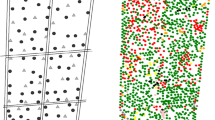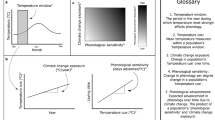Abstract
The regulation of reproductive schedules is an important determinant of avian breeding success. In heterogeneous environments, the optimal breeding period may fluctuate temporally across habitats, often on a spatial scale much shorter than the average dispersal range of individuals. The synchronisation of reproductive events with the most favourable period at a given site therefore involves the integration of a suite of fine-scale environmental signals which contain information about future breeding conditions. In this study, we monitored clutch initiation date of blue tits (Cyanistes caeruleus) breeding in a wide range of environmental conditions (altitude, temperature regimes, habitat type) in Corsica (France) to understand the role of spring temperature and leafing phenology on the precise fine-tuning of egg laying on a local scale. Timing of breeding in blue tits was strongly correlated with phenology of the dominant vegetation (r 2 = 0.87). In contrast, spring temperature was not as robust a predictor of the timing of breeding, because a large part of the residual variation in egg-laying date was accounted by differences (ca. 2 weeks) in the development of the vegetation between habitat types (evergreen vs. deciduous oak forests). Female blue tits therefore appear to use the environmental variable (vegetation phenology) that is most closely linked to the future production of insect prey in order to accurately time laying over the entire spatio-temporal breeding landscape.



Similar content being viewed by others
References
Bears H, Drever MC, Martin K (2008) Comparative morphology of dark-eyed juncos Junco hyemalis breeding at two elevations: a common aviary experiment. J Avian Biol 39:152–162
Blondel J (1985) Comparative breeding ecology of the blue tit and the coal tit in mainland and island Mediterranean habitats. J Anim Ecol 54:531–556
Blondel J, Dias PC, Maistre M, Perret P (1993) Habitat heterogeneity and life history variation of Mediterranean blue tits (Parus caeruleus). Auk 110:511–520
Blondel J, Dias PC, Perret P, Maistre M, Lambrechts MM (1999) Selection-based biodiversity at a small spatial scale in a low-dispersing insular bird. Science 285:1399–1402
Blondel J, Thomas DW, Charmantier A, Perret P, Bourgault P, Lambrechts MM (2006) A thirty-year study of phenotypic and genetic variation of blue tits in Mediterranean mosaics. Bioscience 56:661–673
Bourgault P, Caro SP, Perret P (2006) Do blue tits time their breeding based on cues obtained by consuming buds? J Field Ornithol 77:399–403
Bowlin MS, Winkler DW (2004) Natural variation in flight performance is related to timing of breeding in tree swallows (Tachycineta bicolor) in New York. Auk 121:345–353
Bradshaw WE, Holzapfel CM (2006) Evolutionary response to rapid climate change. Science 312:1477–1478
Buse A, Good JE (1996) Synchronization of larval emergence in winter moth (Operophtera brumata L.) and budburst in pedunculate oak (Quercus robur L.) under simulated climate change. Ecol Entomol 21:335–343
Caro SP, Charmantier A, Lambrechts MM, Blondel J, Balthazart J, Williams TD (2008) Local adaptation of timing of breeding: females are in the driver’s seat. Funct Ecol. doi 10.1111/j.1365-2435.2008.01486.x
Chmielewski FM, Rötzer T (2001) Response of tree phenology to climate change across Europe. Agric For Meteorol 108:101–112
Chuine I, Cour P (1999) Climatic determinants of budburst seasonality in four temperate-zone tree species. New Phythol 143:339–349
Clutton-Brock TH (1988) Reproductive success. University of Chicago Press, Chicago
Coppack T (2007) Experimental determination of the photoperiodic basis for geographic variation in avian seasonality. J Ornithol (suppl) 148:459–467
Crick HQP, Dudley C, Glue DE, Thomson DL (1997) UK birds are laying eggs earlier. Nature 388:526
Dawson A (2005) The effect of temperature on photoperiodically regulated gonadal maturation, regression and moult in starlings—potential consequences of climate change. Funct Ecol 19:995–1000
Dias PC, Blondel J (1996) Local specialization and maladaptation in the Mediterranean blue tit (Parus caeruleus). Oecologia 107:79–86
du Merle P, Mazet R (1983) Stades phénologiques et infestation par Tortrix viridana L. (Lep., Tortricidae) des bourgeons du chêne pubescent et du chêne vert. Acta Oecol 4:47–53
Gienapp P, Hemerik L, Visser ME (2005) A new statistical tool to predict phenology under climate change scenarios. Global Chang Biol 11:600–606
Hughes L (2000) Biological consequences of global warming: is the signal already apparent? Trends Ecol Evol 15:56–61
Jacobs JD, Wingfield JC (2000) Endocrine control of life-cycle stages: a constraint on response to the environment? Condor 102:35–51
Lack D (1966) Population studies of birds. Oxford University Press, Oxford
Lambrechts MM, Perret P (2000) A long photoperiod overrides non-photoperiodic factors in blue tits’ timing of reproduction. Proc R Soc Lond B 267:585–588
Lambrechts M, Blondel J, Hurtrez-Bousses S, Maistre M, Perret P (1997) Adaptive inter-population differences in blue tit life history traits on Corsica. Evol Ecol 11:599–612
Lambrechts MM, Caro S, Charmantier A, Gross N, Galan MJ, Perret P, Cartan-Son M, Dias PC, Blondel J, Thomas DW (2004) Habitat quality as a predictor of spatial variation in blue tit reproductive performance: a multi-plot analysis in a heterogeneous landscape. Oecologia 141:555–561
Loe LE, Bonenfant C, Mysterud A, Gaillard JM, Langvatn R, Klein F, Calenge C, Ergon T, Pettorelli N, Stenseth NC (2005) Climate predictability and breeding phenology in red deer: timing and synchrony of rutting and calving in Norway and France. J Anim Ecol 74:579–588
Meijer T, Drent R (1999) Re-examination of the capital and income dichotomy in breeding birds. Ibis 141:399–414
Meijer T, Nienaber U, Langer U, Trillmich F (1999) Temperature and timing of egg-laying of European starlings. Condor 101:124–132
Merilä J, Sheldon BC (2001) Avian quantitative genetics. Curr Ornithol 16:179–255
Moller AP (2008) Climate change and micro-geographic variation in laying date. Oecologia 155:845–857
Nager RG, van Noordwijk AJ (1992) Energetic limitation in the egg-laying period of great tits. Proc R Soc Lond B 249:259–263
Nager RG, van Noordwijk AJ (1995) Proximate and ultimate aspects of phenotypic plasticity in timing of great tit breeding in a heterogeneous environment. Am Nat 146:454–474
Nilsson JA (1999) Fitness consequences of timing of reproduction. In: Adams NJ, Slotow RH (eds) Proceedings of the 22nd IOC. BirdLife, South Africa, pp 234–247
Nilsson JA, Källander H (2006) Leafing phenology and timing of egg laying in great tits Parus major and blue tits P. caeruleus. J Avian Biol 37:357–363
Nilsson JA, Svensson E (1996) The cost of reproduction: a new link between current reproductive effort and future reproductive success. Proc R Soc Lond B 263:711–714
Ottersen G, Planque B, Belgrano A, Post E, Reid PC, Stenseth NC (2001) Ecological effects of the North Atlantic Oscillation. Oecologia 128:1–14
Parmesan C, Yohe G (2003) A globally coherent fingerprint of climate change impacts across natural systems. Nature 421:37–42
Penuelas J, Filella I, Comas P (2002) Changed plant and animal life cycles from 1952 to 2000 in the Mediterranean region. Global Chang Biol 8:531–544
Perfito N, Tramontin AD, Meddle S, Sharp PJ, Afik D, Gee J, Ishii S, Kikuchi M, Wingfield JC (2004) Reproductive development according to elevation in a seasonally breeding male song-bird. Oecologia 140:201–210
Perfito N, Meddle SL, Tramontin AD, Sharp PJ, Wingfield JC (2005) Seasonal gonadal recrudescence in song sparrows: response to temperature cues. Gen Comp Endocr 143:121–128
Pinheiro JC, Bates DM (2000) Mixed-effects models in S and S-Plus. Springer, New York
Réale D, McAdam AG, Boutin S, Berteaux D (2003) Genetic and plastic responses of a northern mammal to climate change. Proc R Soc Lond B 270:591–596
Root TL, Price JT, Hall KR, Schneider SH, Rosenzweig C, Pounds JA (2003) Fingerprints of global warming on wild animals and plants. Nature 421:57–60
Silverin B, Viebke PA (1994) Low temperatures affect the photoperiodically induced LH and testicular cycles differently in closely related species of tits (Parus spp.). Horm Behav 28:199–206
Silverin B, Wingfield J, Stokkan KA, Massa R, Järvinen A, Andersson NA, Lambrechts M, Sorace A, Blomqvist D (2008) Ambient temperature effects on photo induced gonadal cycles and hormonal secretion patterns in Great Tits from three different breeding latitudes. Horm Behav 54:60–68
Sokal RR, Rohlf FJ (1995) Biometry: the principles and practice of statistics in biological research, 3rd edn. Freeman, New York
Thomas DW, Blondel J, Perret P, Lambrechts MM, Speakman JR (2001) Energetic and fitness costs of mismatching resource supply and demand in seasonally breeding birds. Science 291:2598–2600
Thomas DW, Bourgault P, Shipley B, Perret P, Blondel J (2009) Context-dependent shifts in the weighting of environmental cues that initiate breeding in a temperate passerine, the Corsican blue tit (Cyanistes caeruleus). Auk (in press)
Tramontin AD, Wingfield JC, Brenowitz PA (1999) Contributions of social cues and photoperiod to seasonal plasticity in the adult avian song control system. J Neurosci 19:476–483
Tremblay I, Thomas DW, Lambrechts MM, Blondel J, Perret P (2003) Variation in blue tit breeding performance across gradients in habitat richness. Ecology 84:3033–3043
van Balen JH (1973) A comparative study of the breeding ecology of the great tit Parus major in different habitats. Ardea 61:1–93
van Dongen S, Backeljau T, Matthysen E, Dhondt AA (1997) Synchronization of hatching date with budburst of individual host trees (Quercus robur) in the winter moth (Operophtera brumata) and its fitness consequences. J Anim Ecol 66:113–121
Verhulst S, Tinbergen JM (1991) Experimental evidence for a causal relationship between timing and success of reproduction in the great tit Parus m. major. J Anim Ecol 60:269–282
Visser ME (2008) Keeping up with a warming world; assessing the rate of adaptation to climate change. Proc R Soc Lond B 275:649–659
Visser ME, Holleman LJM (2001) Warmer springs disrupt the synchrony of oak and winter moth phenology. Proc R Soc Lond B 268:289–294
Visser ME, Lambrechts MM (1999) Information constraints in the timing of reproduction in temperate zone birds: great and blue tits. In: Adams NJ, Slotow RH (eds) Proceedings of the 22nd IOC. BirdLife South Africa, Durban, Johannesburg, pp 279–294
Visser ME, Both C, Lambrechts MM (2004) Global climate change leads to mistimed avian reproduction. Adv Ecol Res 35:89–110
Visser ME, Holleman LJM, Caro SP (2009) Temperature has a causal effect on avian timing of reproduction. Proc R Soc Lond B 276:2323–2331
Wingfield JC, Hahn TP, Levin R, Honey P (1992) Environmental predictability and control of gonadal cycles in birds. J Exp Zool 261:214–231
Wingfield JC, Visser ME, Williams TD (2008) Integration of ecology and endocrinology in avian reproduction: a new synthesis. Philos Trans R Soc B 363:1581–1588
Yom-Tov Y, Wright J (1993) Effect of heating nest boxes on egg laying in the blue tit (Parus caeruleus). Auk 110:95–99
Acknowledgments
We thank A. Mennerat, P.-A. Bernier, P. Garcia-Cournoyer for valuable assistance in the field, and D. and L. Zamboni for providing housing at Muro. We also thank the Association pour l’Etude de l’Environnement du Maquis for housing and laboratory space at Pirio. This research was funded by a NSERC discovery grant to D. W. T., as well as a NSERC doctoral scholarship and by international cooperation funding from the Ministère des Relations Internationales (Québec) and the Ministère Délégué à l’Enseignement Supérieur et à la Recherche (France) to P. B. The research activities complied with relevant laws and regulations of France.
Author information
Authors and Affiliations
Corresponding author
Additional information
Communicated by Esa Lehikoinen.
Don Thomas: Deceased, 30 May 2009.
Rights and permissions
About this article
Cite this article
Bourgault, P., Thomas, D., Perret, P. et al. Spring vegetation phenology is a robust predictor of breeding date across broad landscapes: a multi-site approach using the Corsican blue tit (Cyanistes caeruleus). Oecologia 162, 885–892 (2010). https://doi.org/10.1007/s00442-009-1545-0
Received:
Accepted:
Published:
Issue Date:
DOI: https://doi.org/10.1007/s00442-009-1545-0




